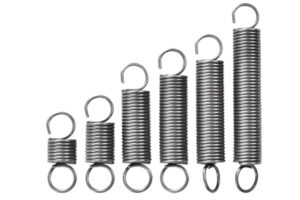Hook structure of tension spring
 There are many types of hook structure of tension spring, among which the more commonly used ones have been incorporated into the national standard. The end shape of the tension spring is mainly shackles, which are formed by bending the end spring coil or steel wire. When designing or selecting the end structure form, the installation method, installation space, load property and other factors of the spring in the hook shall be mainly considered. On the premise of meeting the requirements, the simple structure shape shall be selected as far as possible.
There are many types of hook structure of tension spring, among which the more commonly used ones have been incorporated into the national standard. The end shape of the tension spring is mainly shackles, which are formed by bending the end spring coil or steel wire. When designing or selecting the end structure form, the installation method, installation space, load property and other factors of the spring in the hook shall be mainly considered. On the premise of meeting the requirements, the simple structure shape shall be selected as far as possible.
1. The semicircle shackle is formed by bending the half of the spring coil at the end of the spring, and is used for occasions with limited space.
2. Torsion round shackle is formed by bending and twisting the spring coil at the end of the spring to the center. The high stress is formed at the bending and twisting position. It is suitable for springs with large winding ratio and small load.
3. Eccentric circular shackle is formed by bending the end spring coil. The shackle is located at the tangent position of the edge of the spring coil. Due to the eccentricity of the load and the 90-degree bending at the root of the shackle, the steel wire bears a large additional stress. This end structure is suitable for springs with medium winding ratio of 8~15 and small or unimportant load.
The pressure center of the circular hook and ring in the middle of the spring coil is also formed by bending and pressing the end spring coil to the center. Compared with the eccentric circular hook and ring, it can avoid the eccentricity of the load, and is more safe and reliable. It is widely used for the spring with the winding ratio C<20 and bearing higher load.
LV and LM are long-arm shackles, which are complex in processing, and should be avoided as far as possible. All shackles formed by bending process produce relatively large stress concentration at the bending of steel wire. Therefore, the end structure of shackles formed by bending process is recommended to be applied to springs with material diameter less than 4mm. However, due to its simplicity, this method is sometimes used for springs with material diameter of about 10mm. In order to reduce stress concentration, additional hook and ring structure can be adopted, such as adjustable structure. Screw the cylindrical plug with screw into both ends of the spring for 1.5-2.5 turns, and add another screw on the cylindrical plug. This structure is applicable to springs with material diameter greater than 5mm. The end of the spring can also be made into a conical closed end, and a rotatable shackle can be added. The relative position of the shackles at both ends can be in a straight line or at 90 degrees to each other, or at any desired angle.







